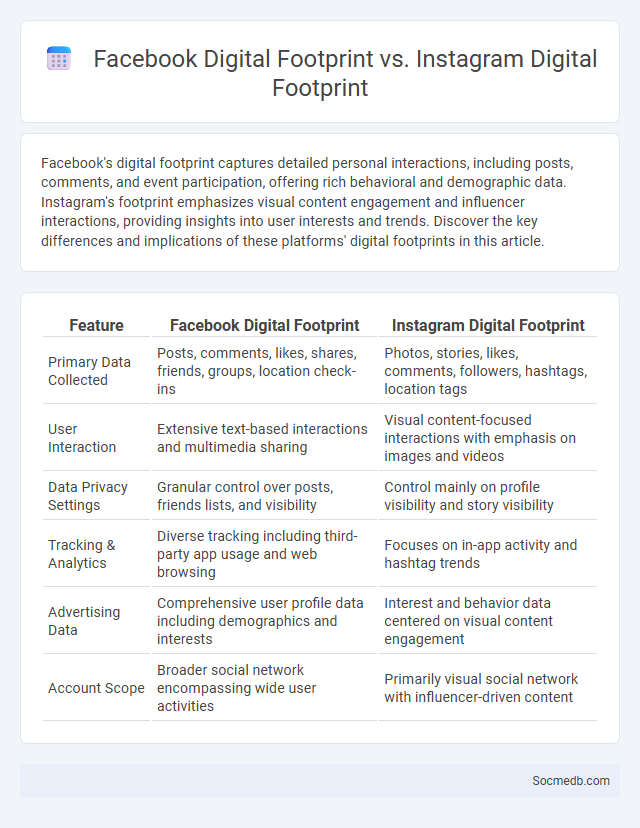
Photo illustration: Facebook Digital Footprint vs Instagram Digital Footprint
Facebook's digital footprint captures detailed personal interactions, including posts, comments, and event participation, offering rich behavioral and demographic data. Instagram's footprint emphasizes visual content engagement and influencer interactions, providing insights into user interests and trends. Discover the key differences and implications of these platforms' digital footprints in this article.
Table of Comparison
| Feature | Facebook Digital Footprint | Instagram Digital Footprint |
|---|---|---|
| Primary Data Collected | Posts, comments, likes, shares, friends, groups, location check-ins | Photos, stories, likes, comments, followers, hashtags, location tags |
| User Interaction | Extensive text-based interactions and multimedia sharing | Visual content-focused interactions with emphasis on images and videos |
| Data Privacy Settings | Granular control over posts, friends lists, and visibility | Control mainly on profile visibility and story visibility |
| Tracking & Analytics | Diverse tracking including third-party app usage and web browsing | Focuses on in-app activity and hashtag trends |
| Advertising Data | Comprehensive user profile data including demographics and interests | Interest and behavior data centered on visual content engagement |
| Account Scope | Broader social network encompassing wide user activities | Primarily visual social network with influencer-driven content |
Understanding Digital Footprints: An Overview
Understanding digital footprints involves recognizing the traces of your online activities, including posts, comments, and browsing history, that are stored and analyzed by social media platforms. These footprints influence your online reputation and privacy, as they can be accessed by advertisers, employers, and other third parties to form a profile of your behavior and preferences. Managing your digital footprint effectively requires awareness of privacy settings and thoughtful sharing to protect your personal information and maintain control over your online presence.
Facebook Digital Footprint: Key Characteristics
Facebook's digital footprint is defined by extensive personal data collection, including user interactions, location check-ins, and content sharing patterns. The platform leverages algorithms to analyze posts, likes, and network connections, creating detailed user profiles for targeted advertising. Privacy settings and data-sharing preferences significantly influence the scope and visibility of the digital footprint on Facebook.
Instagram Digital Footprint: Unique Features
Instagram's digital footprint is shaped by features like Stories, Reels, and IGTV, which allow users to create diverse, shareable content that enhances visibility and engagement. The platform's algorithm prioritizes user interactions, making your likes, comments, and follows crucial for content distribution and audience growth. Hashtags and geotags further optimize reach, helping your posts connect with targeted communities and expand your digital presence.
Scope of Data Collection: Facebook vs Instagram
Facebook collects extensive user data including personal information, browsing habits, location, device details, and interaction patterns across its platform and third-party sites, enabling deep ad targeting and analytics. Instagram, owned by Facebook, gathers similar data types but emphasizes visual content engagement, follower interactions, and hashtag usage, enhancing content personalization and influencer marketing insights. Both platforms integrate data streams to build comprehensive user profiles, optimizing advertising precision within the Meta ecosystem.
Privacy Settings: Comparing Facebook and Instagram
Facebook and Instagram offer robust privacy settings that allow users to control who can view their profiles and posts, with Facebook providing more granular options such as custom friend lists and activity log controls. Instagram focuses on simplicity, offering private accounts, close friends lists for stories, and limits on message requests to protect user interactions. Both platforms continuously update privacy features to address user concerns and comply with data protection regulations like GDPR and CCPA.
User Behavior and Content Sharing Differences
User behavior on social media varies significantly across platforms, influenced by factors such as age, interests, and privacy concerns, which directly affect content sharing patterns. Visual platforms like Instagram and TikTok encourage short, engaging multimedia posts, while Twitter promotes concise, text-based interactions often centered on news and opinions. Understanding these differences helps optimize content strategies, increase user engagement, and enhance audience targeting across diverse social networks.
Third-Party Tracking on Facebook and Instagram
Third-party tracking on Facebook and Instagram involves external advertisers and data brokers collecting user data through embedded pixels, cookies, and SDKs to monitor online behavior and preferences. This tracking enables highly targeted advertising by leveraging users' browsing history, app interactions, and demographic information across multiple platforms. Privacy concerns have risen due to the extensive data sharing with third parties, prompting regulatory scrutiny and increased use of tracking prevention tools.
Long-Term Impact of Social Media Footprints
Social media footprints create a permanent digital trail that can affect personal and professional reputations for years. Employers and institutions increasingly use these footprints for background checks, highlighting the importance of mindful content sharing. Maintaining a positive online presence is crucial for long-term career opportunities and personal relationships.
Managing and Minimizing Your Digital Footprint
Managing and minimizing your digital footprint requires regularly reviewing privacy settings on social media platforms like Facebook, Instagram, and Twitter to control what personal information is visible. Deleting old posts, limiting the sharing of sensitive data, and using tools to monitor your online presence can significantly reduce exposure to data breaches or identity theft. Your proactive efforts in curating your digital footprint help protect your reputation and enhance online security.
Best Practices for Protecting Your Online Identity
Securing your online identity on social media involves using strong, unique passwords combined with two-factor authentication to prevent unauthorized access. Regularly reviewing privacy settings and limiting the amount of personal information shared reduces risks of identity theft and cyberstalking. Staying vigilant against phishing attempts and avoiding suspicious links further protects your digital presence from malicious attacks.
 socmedb.com
socmedb.com